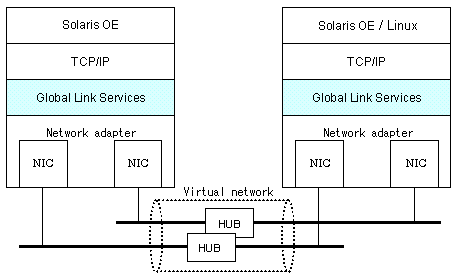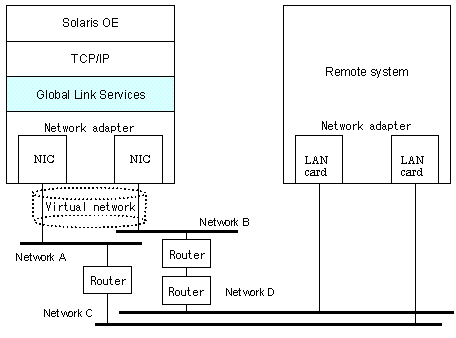

| PRIMECLUSTER Global Link Services Configuration and Administration Guide: Redundant Line Control Function 4.1 (for Solaris(TM) Operating System) |
Contents
Index
 
|
| Chapter 1 Overview |
The redundant line control function provides a high-reliability communication infrastructure that supports continuous transmission in the event of a network path or card failure by making transmission routes redundant with multiple NIC (Network Interface Cards).
GLS enables the following network control methods:
In Fast switching mode, a redundant transmission route between Solaris servers or Linux servers in the same network is used so that the total amount of data transferred can be increased, and that the data communication can be continued even if the transmission route fails. It also enables higher levels of throughput through redundant transmission routes. GLS performs early failure detection, so when one transmission route fails, the failed route will be cut off then the system will be operated on a reduced scale. The compatible hosts are PRIMEPOWER, GP7000F, Fujitsu S series, GP-S, PRIMERGY, and PRIMEQUEST.
Note that fast switching mode cannot be used to communicate with hosts on the other networks beyond the router.

RIP mode enables the system to control the network line by standard TCP/IP routing protocol called Routing Information Protocol (RIP). In this mode, one of the duplex paths is used according to the RIP information. When a failure occurs, the system switches to the alternative route. The standard protocol allows communications with other remote systems and also with host systems on the other networks connected via routers. However, path switching in the RIP mode is slow and time-consuming.

In NIC switching mode, redundant NICs (LAN cards) are connected to each other on the same network and used exclusively. If one transmission route fails, ongoing communications will be switched to the other transmission route. There are no restrictions on remote systems to communicate with.
Note that NIC switching mode can be used to communicate with any hosts on the other networks beyond the router.

GS/SURE linkage mode enables the system to control lines by using a Fujitsu method for high-reliability communication between the system and Global Server or SURE SYSTEM. In this mode, duplicated lines are used concurrently. During normal operation, lines are automatically assigned to each TCP connection for communication. In the event of a fault, the system disconnects the faulty line and operates on a reduced scale by moving the TCP connection to the normal line. This mode provides the following connection functions (Hereafter, GS refers to Global Server and SURE refers to SURE SYSTEM).
It is possible to directly connect to GS and SURE on the same LAN.

It is possible to connect to an optional system by relaying a TCP connection with SURE. This function is available only when a relay device is SURE.

 1.1.1 Functional comparison
1.1.1 Functional comparison 1.1.2 Criteria for selecting redundant line control methods
1.1.2 Criteria for selecting redundant line control methods
Contents
Index
 
|